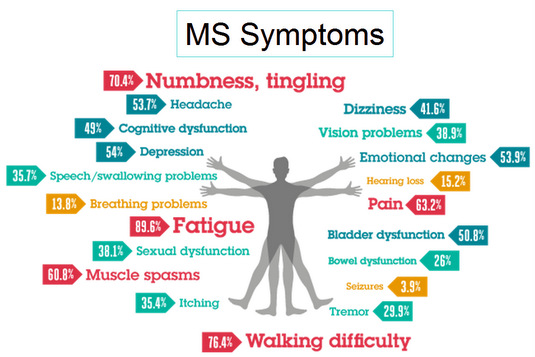Multiple
Sclerosis is a potentially disabling disease that affects the brain and spinal
cord. The disease attacks one’s immune system around the myelin sheath that
protects and covers nerve fibers and causes communication problems between the
brain and rest of the body. It is considered an autoimmune disease, in which
the body attacks its own tissues. Eventually the disease can cause the nerves
to deteriorate or become permanently damaged. Here is a link to a youtube video describing MS: https://www.youtube.com/watch?v=Naecv3h868c
 There
are multiple symptoms that associate with this disease, and they are based off
the amount of damage to the nerve and which nerves are being targeted. A few of
the main symptoms may include numbness or weakness in the effected area,
partial or complete loss of vision, prolonged double vision, tingling or pain
in parts of your body, slurred speech, fatigue, and dizziness. As well if you
or a loved one are experiencing any of these symptoms, it is recommended to
consult with a physician or doctor.
There
are multiple symptoms that associate with this disease, and they are based off
the amount of damage to the nerve and which nerves are being targeted. A few of
the main symptoms may include numbness or weakness in the effected area,
partial or complete loss of vision, prolonged double vision, tingling or pain
in parts of your body, slurred speech, fatigue, and dizziness. As well if you
or a loved one are experiencing any of these symptoms, it is recommended to
consult with a physician or doctor.
Risk
factors are extremely important with this disease because of the course it can
take on your body, as well as the time it takes. MS can develop at any age, but
is common more among adults between 15-60 years of age. Another interesting
factor is that women are twice as likely to obtain this disease. The reason for
this is still unknown, but some scientists believe it is based off of genes.
Women with MS were more likely to have a variation of a gene that can produce
high levels of protein that aggravates and inflames MS symptoms. Another common
risk factor that is involved in increasing multiple diseases is smoking. Smoking
increases one’s chance of symptoms showing signs of MS, as well as symptoms
occurring a second time that confirm MS. There are more symptoms, such as autoimmune
diseases, viral infections, climate, race, and family history. It is important
to follow up with family history, infections, and diseases when going for
check-ups, or if something feels out of the ordinary.
The
course the multiple sclerosis takes throughout the body is somewhat difficult
to understand, so hopefully the following sentences will help clear up
questions. Most patients have a relapsing-remitting disease course, which means
new symptoms can occur periodically, as well as old symptoms relapsing from
time to time. These time periods can be following by a time of silence with the
disease, which can last up to years. Body temperature increasing can cause symptoms
to worsen as well. Eventually most patients start to see symptoms that keep a
steady progression, and do not seem to disappear; this is when they enter
secondary- progressive MS. The rate at which the disease worsens from here is
unknown, and different with each individual. Lastly, some individuals develop a
gradual onset of symptoms, without relapses, and this is called primary-
progressive MS.
Citations:
"Multiple Sclerosis." Overview. 2015. Web. 23 Mar. 2016.
"Multiple Sclerosis." Symptoms and Causes. 2015. Web. 23 Mar. 2016. <http://www.mayoclinic.org/diseases-conditions/multiple-sclerosis/symptoms-causes/dxc-20131884>.


No comments:
Post a Comment